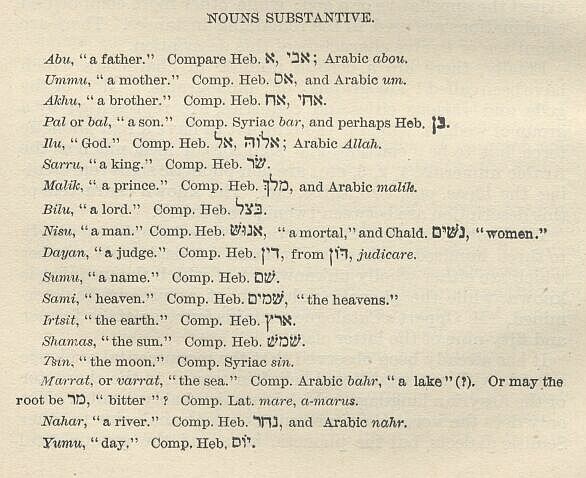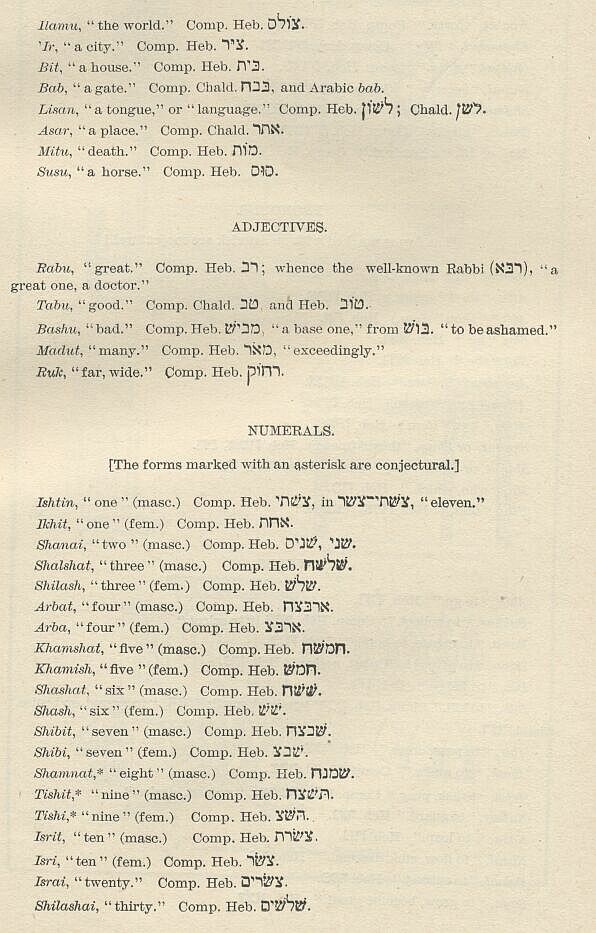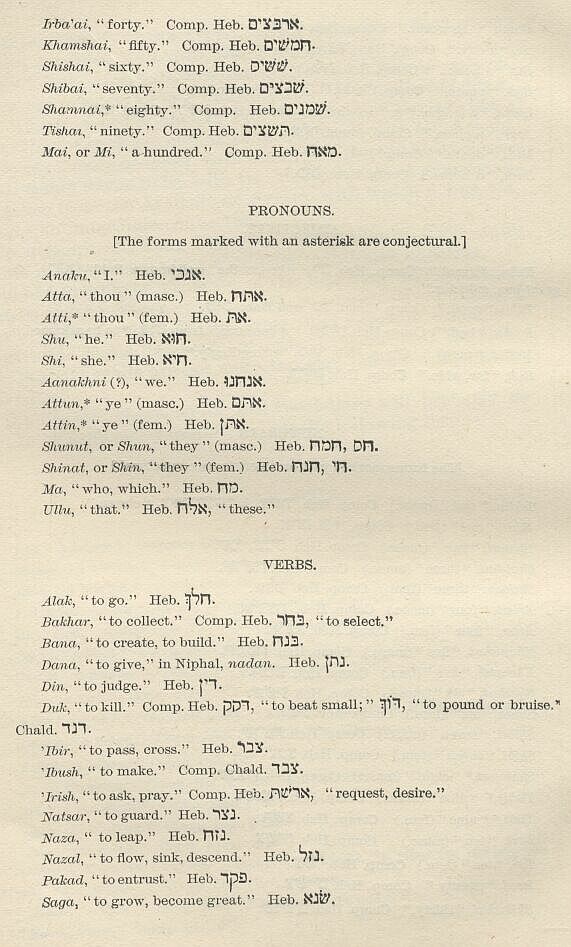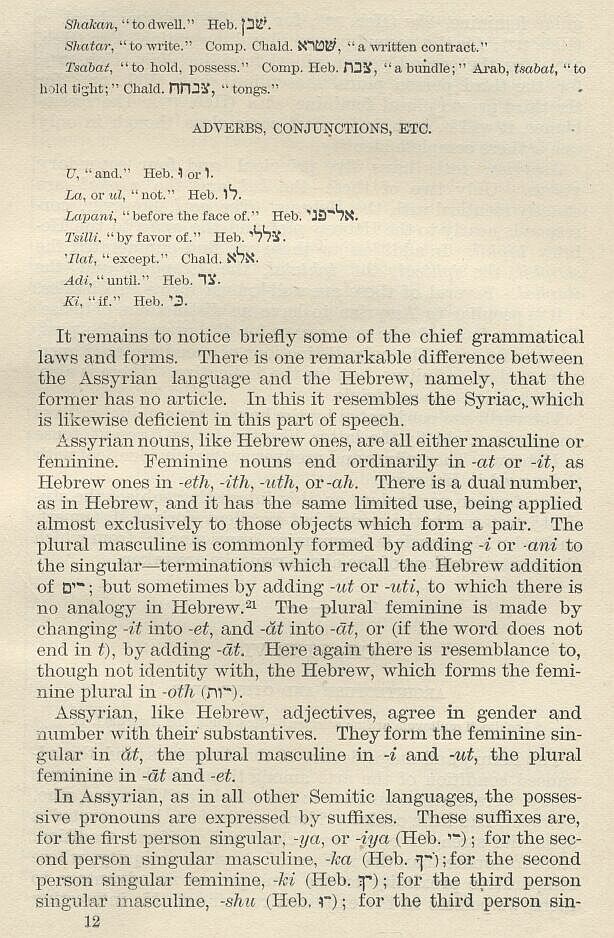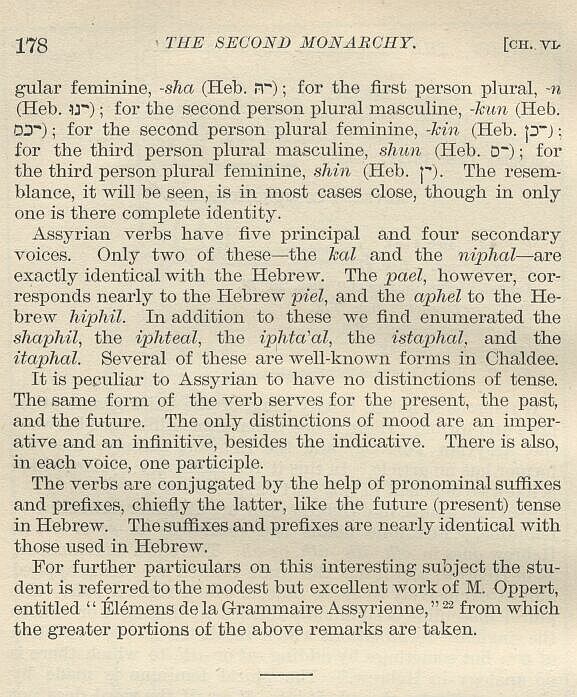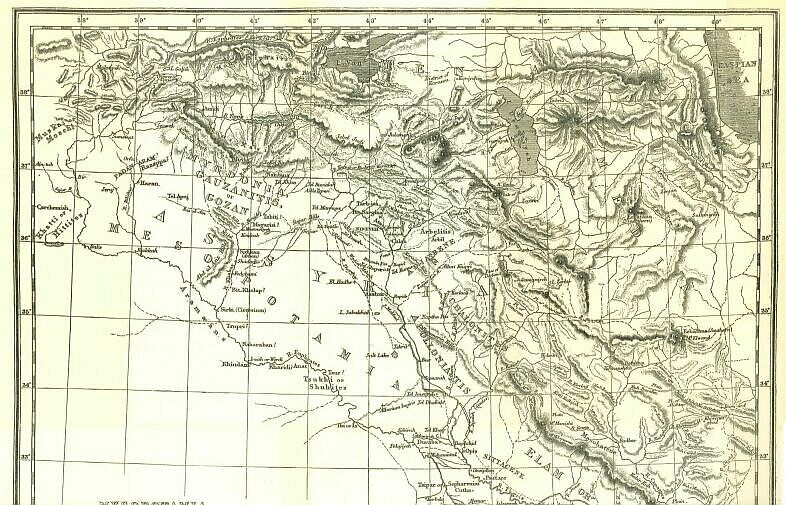
| CHAPTER III. | THE PEOPLE |
| CHAPTER IV. | THE CAPITAL |
| CHAPTER V. | LANGUAGE AND WRITING |
|
87. Mesopotamian captives, from an Egyptian monument (Wilkinson) 88. Limbs of Assyrians, from the sculptures (after Layard) 89. Capture of a city, Nimrud (ditto) 90. Captives of Sargon, Khorsabad (after Botta) 91. Captive women in a cart, Nimrud (Layard) 92. Ruins of Nineveh (reduced by the Author from Captain Jones's survey) 93. Khosr-Su and mound of Nebbi-Yunus (after Layard) 94. Gate in the north wall, Nineveh (ditto) 95. Outer defences of Nineveh, in their present condition (ditto) 96. Assyrian cylinder (after Birch) 97. Assyrian seals (after Layard) 98. Assyrian clay tablets (ditto) 99. Black obelisk, from Nimrud (after Birch) |

"The Assyrian was a cedar in Lebanon, fair of branches, and with a shadowing shroud, and of high stature; and his top was among the thick boughs. . . . Nor was any tree in the garden of God like unto him in his beauty."—EZEK. xxxi. 3 and 8.
The ethnic character of the ancient Assyrians, like that of the Chaldaeans, was in former times a matter of controversy. When nothing was known of the original language of the people beyond the names of certain kings, princes, and generals, believed to have belonged to the race, it was difficult to arrive at any determinate conclusion on the subject. The ingenuity of etymologists displayed itself in suggesting derivations for the words in question, which were sometimes absurd, sometimes plausible, but never more than very doubtful conjectures. No sound historical critic could be content to base a positive view on any such unstable foundation, and nothing remained but to decide the controversy on other than linguistic considerations.
Various grounds existed on which it was felt that a conclusion could be drawn. The Scriptural genealogies connected Asshur with Aran, Pier, and Joktan, the allowed progenitors of the Armaeians or Syrians, the Israelites or Hebrews, and the northern or Joktanian Arabs. The languages, physical type, and moral characteristics of these races were well known: they all belonged evidently to a single family the family known to ethnologists as the Semitic. Again, the manners and customs, especially the religious customs, of the Assyrians connected then plainly with the Syrians and Phoenicians, with whose practices they were closely allied. Further it was observed that the modern Chaldaeans of Kurdistan, who regard themselves as descendants of the ancient inhabitants of the neighboring Assyria, still speak a Semitic dialect. These three distinct and convergent lines of testimony were sufficient to justify historians in the conclusion, which they commonly drew, that the ancient Assyrians belonged to the Semitic family, and were more or less closely connected with the Syrians, the (later) Babylonians, the Phoenicians, the Israelites, and the Arabs of the northern portion of the peninsula.
Recent linguistic discoveries have entirely confirmed the conclusion thus, arrived at. We now possess in the engraved slabs, the clay tablets, the cylinders, and the bricks, exhumed from the ruins of the great Assyrian cities, copious documentary evidence of the character of the Assyrian language, and (so far as language is a proof) of the ethnic character of the race. It appears to be doubted by none who have examined the evidence, that the language of these records is Semitic. However imperfect the acquaintance which our best Oriental archaeologists have as yet obtained with this ancient and difficult form of speech, its connection with the Syriac, the later Babylonian, the Hebrew, and the Arabic does not seem to admit of a doubt.
Another curious confirmation of the ordinary belief is to be found in the physical characteristics of the people, as revealed to us by the sculptures. Few persons in any way familiar with these works of art can have failed to remark the striking resemblance to the Jewish physiognomy which is presented by the sculptured effigies of the Assyrians. The forehead straight but not high, the full brow, the eye large and almond-shaped, the aquiline nose, a little coarse at the end, and unduly depressed, the strong, firm mouth, with lips somewhat over thick, the well-formed chin—best seen in the representation of eunuchs—the abundant hair and ample beard, both colored as black—all these recall the chief peculiarities of the Jew more especially as he appears in southern countries. [PLATE XXXIII., Fig. 3.] They are less like the traits of the Arab, though to them also they bear a considerable resemblance. Chateaubriand's description of the Bedouin—"la tete ovale, le front haut et argue, le nez aquilia, les yeux grandes et coupe en amandes, le regard humide et singulierement doux" would serve in many respects equally well for a description of the physiognomy of the Assyrians, as they appear upon the monuments. The traits, in fact, are for the most part common to the Semitic race generally, and not distinctive of any particular subdivision of it. They are seen now alike in the Arab, the Jew, and the Chalaedeans of Kurdistan, while anciently they not only characterized the Assyrians, but probably belonged also to the Phoenicians, the Syrians, and other minor Semetic races. It is evident, even from the mannered and conventional sculptures of Egypt, that the physiognomy was regarded as characteristic of the western Asiatic races. Three captives on the monuments of Amenophis III., represented as belonging to the Patana (people of Bashan?), the Asuru (Assyrians), and the Karukamishi (people of Carchemish), present to us the sane style of face, only slightly modified by Egyptian ideas. [PLATE. XXXIV., Fig. 1.]
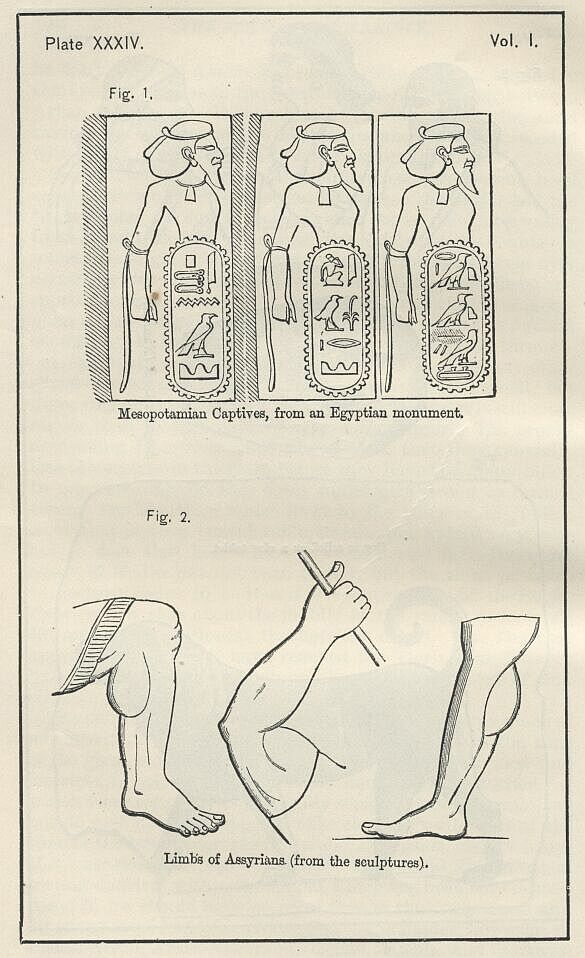
White in face the Assyrians appear thus to have borne a most close resemblance to the Jews, in shape and make they are perhaps more nearly represented by their descendants, the Chaldaeans of Kurdistan. While the Oriental Jew has a spare form and a weak muscular development, the Assyrian, like the modern Chaldaean, is robust, broad-shouldered, and large-limbed. Nowhere have we a race represented to us monumentally of a stronger or more muscular type than the ancient Assyrian. The great brawny limbs are too large for beauty; but they indicate a physical power which we may well believe to have belonged to this nation—the Romans of Asia—the resolute and sturdy people which succeeded in imposing its yoke upon all its neighbors. [PLATE XXXIV., Fig, 2.]
If from physical we proceed to mental characteristics, we seem again to have in the Jewish character the best and closest analogy to the Assyrian. In the first place, there is observable in each a strong and marked prominency of the religious principle. Inscriptions of Assyrian kings begin and end, almost without exception, with praises, invocations, and prayers to the principal objects of their adoration. All the monarch's successes, all his conquests and victories, and even his good fortune in the chase, are ascribed continually to the protection and favor of guardian deities. Wherever he goes, he takes care to "set up the emblems of Asshur," or of "the great gods;" and forces the vanquished to do them homage. The choicest of the spoil is dedicated as a thank-offering in the temples. The temples themselves are adorned, repaired, beautified, enlarged, increased in manner, by almost, every monarch. The kings worship them in person, and offer sacrifices. They embellish their palaces, not only with representations of their own victories and hunting expeditions, but also with religious figures—the emblems of some of the principal deities, and with scenes in which are portrayed acts of adoration. Their signets, and indeed those of the Assyrians generally, have a religious character. In every way religion seems to hold a marked and prominent place in the thoughts of the people, who fight more for the honor of their gods than even of their king, and aim at extending their belief as much as their dominion.
Again, combined with this prominency of the religious principle, is a sensuousness—such as we observe in Judaism continually struggling against a higher and purer element—but which in this less favored branch of the Semitic family reigns uncontrolled, and gives to its religion a gross, material, and even voluptuous character. The ideal and the spiritual find little favor with this practical people, which, not content with symbols, must have gods of wood and stone whereto to pray, and which in its complicated mythological system, its priestly hierarchy, its gorgeous ceremonial, and finally in its lascivious ceremonies, is a counterpart to that Egypt, from which the Jew was privileged to make his escape.
The Assyrians are characterized in Scripture as "a fierce people." Their victories seem to have been owing to their combining individual bravery and hardihood with a skill and proficiency in the arts of war not possessed by their more uncivilized neighbors. This bravery and hardihood were kept up, partly (like that of the Romans) by their perpetual wars, partly by the training afforded to their manly qualities by the pursuit and destruction of wild animals. The lion—the king of beasts—abounded in their country, together with many other dangerous and ferocious animals. Unlike the ordinary Asiatic, who trembles before the great beasts of prey and avoids a collision by flight if possible, the ancient Assyrian sought out the strongest and fiercest of the animals, provoked them to the encounter, and engaged with them in hand-to-hand combats. The spirit of Nimrod, the "mighty hunter before the Lord," not only animated his own people, but spread on from them to their northern neighbors; and, as far as we can judge by the monuments, prevailed even more in Assyria than in Chaldaea itself. The favorite objects of chase with the Assyrians seem to have been the lion and the wild bull, both beasts of vast strength and courage, which could not be attacked without great danger to the bold assailant.
No doubt the courage of the Assyrians was tinged with ferocity. The nation was "a mighty and strong one, which, as a tempest of hail and a destroying storm, as a flood of mighty waters overflowing, cast down to the earth with the hand." Its capital might well deserve to be called "a bloody city," or "a city of bloods." Few conquering races have been tender-hearted, or much inclined to spare; and undoubtedly carnage, ruin, and desolation followed upon the track of an Assyrian army, and raised feelings of fear and hatred among their adversaries. But we have no reason to believe that the nation was especially bloodthirsty or unfeeling. The mutilation of the slain—not by way of insult, but in proof of their slayer's prowess was indeed practised among them; but otherwise there is little indication of any barbarous, much less of any really cruel, usages. The Assyrian listens to the enemy who asks for quarter; he prefers making prisoners to slaying; he is very terrible in the battle and the assault, but afterwards he forgives, and spares. Of course in some cases he makes exceptions. When a town has rebelled and been subdued, he impales some of the most guilty [PLATE XXXV., Fig. 1]; and in two or three instances prisoners are represented as led before the king by a rope fastened to a ring which passes through the under lip, while now and then one appears in the act of being flayed with it knife [PLATE XXXV., Fig. 2.] But, generally, captives are either released, or else transferred, without unnecessary suffering, from their own country to some other portion of the empire. There seems even to be something of real tenderness in the treatment of captured women, who are never manacled, and are often allowed to ride on mules, or in carts. [PLATE XXXVI., Fig. 1.]
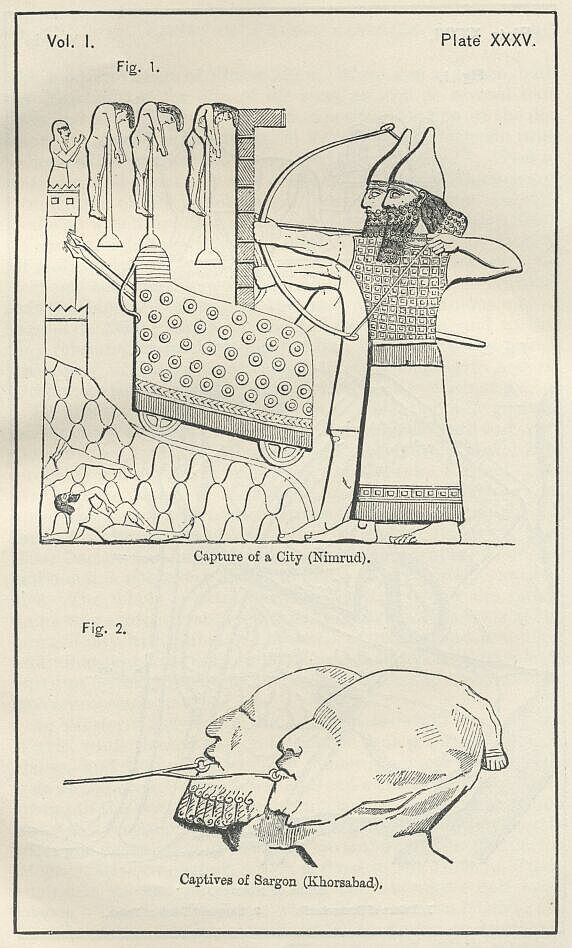
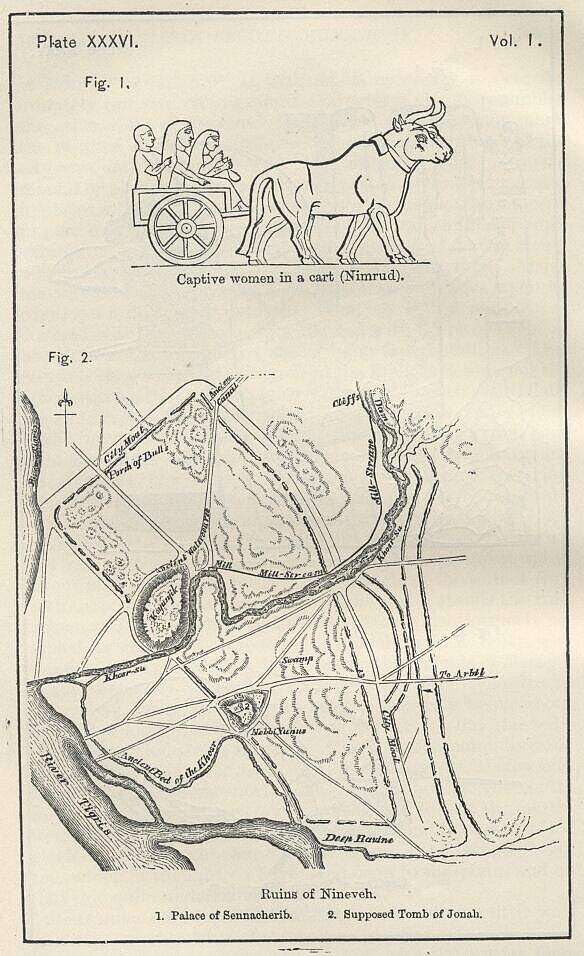
The worst feature in the character of the Assyrians was their treachery. "Woe to thee that spoilest, though thou wast not spoiled, and dealest treacherously, though they dealt not treacherously with thee!" is the denunciation of the evangelical prophet. And in the same spirit the author of "The Burthen of Nineveh" declares that city to be "full of lies and robbery"—or, more correctly, full of lying and violence. Falsehood and treachery are commonly regarded as the vices of the weak, who are driven to defend themselves against superior strength by the weapon of cunning; but they are perhaps quite as often employed by the strong as furnishing short cuts to success, and even where the moral standard is low, as being in themselves creditable. It certainly was not necessity which made the Assyrians covenant-breakers; it seems to have been in part the wantonness of power—because they "despised the cities and regarded no man;" perhaps it was in part also their imperfect moral perception, which may have failed to draw the proper distinction between craft and cleverness.
Another unpleasant feature in the Assyrian character—but one at which we can feel no surprise—was their pride. This is the quality which draws forth the sternest denunciations of Scripture, and is expressly declared to have called down the Divine judgments upon the race. Isaiah, Ezekiel, and Zephaniah alike dwell upon it. It pervades the inscriptions. Without being so rampant or offensive as the pride of some Orientals—as, for instance, the Chinese, it is of a marked and decided color: the Assyrian feels himself infinitely superior to all the nations with whom he is brought into contact; he alone enjoys the favor of the gods; he alone is either truly wise or truly valiant; the armies of his enemies are driven like chaff before him; he sweeps them away, like heaps of stubble; either they fear to fight, or they are at once defeated; he carries his victorious arms just as far as it pleases him, and never under any circumstances admits that he has suffered a reverse. The only merit that he allows to foreigners is some skill in the mechanical and mimetic arts, and his acknowledgment of this is tacit rather than express, being chiefly known from the recorded fact that he employs foreign artists to ornament his edifices.
According to the notions which the Greeks derived from Ctesias, and passed on to the Romans, and through them to the moderns generally, the greatest defect in the Assyrian character—the besetting sin of their leading men—was luxuriousness of living and sensuality. From Ninyas to Sardanapalus—from the commencement to the close of the Empire—a line of voluptuaries, according to Ctesias and his followers, held possession of the throne; and the principle was established from the first, that happiness consisted in freedom from all cares or troubles, and unchecked indulgence in every species of sensual pleasure. This account, intrinsically suspicious, is now directly contradicted by the authentic records which we possess of the warlike character and manly pursuits of so many of the kings. It probably, however, contains a germ of truth. In a flourishing kingdom like Assyria, luxury must have gradually advanced; and when the empire fell under the combined attack of its two most powerful neighbors, no doubt it had lost much of its pristine vigor. The monuments lend some support to the view that luxury was among the causes which produced the fall of Assyria; although it may be questioned whether, even to the last, the predominant spirit was not warlike and manly, or even fierce and violent. Among the many denunciations of Assyria in Scripture, there is only one which can even be thought to point to luxury as a cause of her downfall; and that is a passage of very doubtful interpretation. In general it is her violence, her treachery, and her pride that are denounced. When Nineveh repented in the time of Jonah, it was by each man "turning from his evil way and from the violence which was in their hands." When Nahum announces the final destruction, it is on "the bloody city, full of lies and robbery." In the emblematic language of prophecy, the lion is taken as the fittest among animals to symbolize Assyria, even at this late period of her history. She is still "the lion that did tear in pieces enough for his whelps, and strangled for his lioness, and filled his holes with prey, and his dens with ravin." The favorite national emblem, if it may be so called, is accepted as the true type of the people; and blood, ravin, and robbery are their characteristics in the mind of the Hebrew prophet.
In mental power the Assyrians certainly deserve to be considered as among the foremost of the Asiatic races. They had not perhaps so much originality as the Chaldaeans, from whom they appear to have derived the greater part of their civilization; but in many respects it is clear that they surpassed their instructors, and introduced improvements which gave a greatly increased value and almost a new character to arts previously discovered. The genius of the people will best be seen from the accounts hereafter to be given of their language, their arts, and their system of government. If it must be allowed that these have all a certain smack of rudeness and primitive simplicity, still they are advances upon aught that had previously existed—not only in Mesopotamia—but in the world. Fully to appreciate the Assyrians, we should compare them with the much-lauded Egyptians, who in all important points are very decidedly their inferiors. The spirit and progressive character of their art offers the strongest contrast to the stiff, lifeless, and unchanging conventionalism of the dwellers on the Nile. Their language and alphabet are confessedly in advance of the Egyptian. Their religion is more earnest and less degraded. In courage and military genius their superiority is very striking; for the Egyptians are essentially an unwarlike people. The one point of advantage to which Egypt may fairly lay claim is the grandeur and durability of her architecture. The Assyrian palaces, magnificent, as they undoubtedly were, must yield the palm to the vast structures of Egyptian Thebes. No nation, not even Rome, has equalled Egypt in the size and solemn grandeur of its buildings. But, except in this one respect, the great African kingdom must be regarded as inferior to her Asiatic rival—which was indeed "a cedar in Lebanon, exalted above all the trees of the field—fair in greatness and in the length of his branches—so that all the trees that were in the garden of God envied him, and not one was like unto him in his beauty."
"Fuit et Ninus, imposita Tigri, ad solis occasum spectans, quondam clarissima."—PLIN. H. N. vi. 13.
The site of the great capital of Assyria had generally been regarded as fixed with sufficient certainty to the tract immediately opposite Mosul, alike by local tradition and by the statements of ancient writers, when the discovery by modern travellers of architectural remains of great magnificence at some considerable distance from this position, threw a doubt upon the generally received belief, and made the true situation of the ancient Nineveh once more a matter of controversy. When the noble sculptures and vast palaces of Nimrud were first uncovered, it was natural to suppose that they marked the real site; for it seemed unlikely that any mere provincial city should have been adorned by a long series of monarchs with buildings at once on so grand a scale and so richly ornamented. A passage of Strabo, and another of Ptolemy, were thought to lend confirmation to this theory, which placed the Assyrian capital nearly at the junction of the Upper Zab with the Tigris; and for awhile the old opinion was displaced, and the name of Nineveh was attached very generally in this country to the ruins at Nimrud.
Shortly afterwards a rival claimant started up in the regions further to the north. Excavations carried on at the village of Khorsabad showed that a magnificent palace and a considerable town had existed in Assyrian times at that site. In spite of the obvious objection that the Khorsabad ruins lay at the distance of fifteen miles from the Tigris, which according to every writer of weight anciently washed the walls of Nineveh, it was assumed by the excavator that the discovery of the capital had been reserved for himself, and the splendid work representing the Khorsabad bas-reliefs and inscriptions, which was published in France under the title of "Monument de Ninive," caused the reception of M. Botta's theory in many parts of the Continent.
After awhile an attempt was made to reconcile the rival claims by a theory, the grandeur of which gained it acceptance, despite its improbability. It was suggested that the various ruins, which had hitherto disputed the name, were in fact all included within the circuit of the ancient Nineveh; which was described as a rectangle, or oblong square, eighteen miles long and twelve broad. The remains of Khorsabad, Koyunjik, Nimrud, and Keremles marked the four corners of this vast quadrangle, which contained an area of 216 square miles—about ten times that of London! In confirmation of this view was urged, first, the description in Diodorus, derived probably from Ctesias, which corresponded (it was said) both with the proportions and with the actual distances; and next, the statements contained in the book of Jonah, which (it was argued) implied a city of some such dimensions. The parallel of Babylon, according to the description given by Herodotus, might fairly have been cited as a further argument; since it might have seemed reasonable to suppose that there was no great difference of size between the chief cities of the two kindred empires.
Attractive, however, as this theory is from its grandeur, and harmonious as it must be allowed to be with the reports of the Greeks, we have nevertheless to reject it on two grounds, the one historical and the other topographical. The ruins of Khorsabad, Keremles, Nimrud, and Koyunjik bear on their bricks distinct local titles; and these titles are found attaching to distinct cities in the historical inscriptions. Nimrud, as already observed, is Calah; and Khorsabad is Dur-Sargina, or "the city of Sargon." Keremles has also its own appellation Dur-* * *, "the city of the God [—]." Now the Assyrian writers do not consider these places to be parts of Nineveh, but speak of them as distinct and separate cities. Calah for a long time is the capital, while Nineveh is mentioned as a provincial town. Dur-Sargina is built by Sargon, not at Nineveh, but "near to Nineveh." Scripture, it must be remembered, similarly distinguishes Calah as a place separate from Nineveh, and so far from it that there was room for "a great city" between them. And the geographers, while they give the name of Aturia or Assyria Proper to the country about the one town, call the region which surrounds the other by a distinct name, Calachene. Again, when the country is closely examined, it is found, not only that there are no signs of any continuous town over the space included within the four sites of Nimrud, Keremles. Khorsabad, and Koyunjik, nor any remains of walls or ditches connecting them, but that the four sites themselves are as carefully fortified on what, by the theory we are examining, would be the inside of the city as in other directions. It perhaps need scarcely be added, unless to meet the argument drawn from Diodorus, that the four sites in question are not so placed as to form the "oblong square" of his description, but mark the angles of a rhombus very munch slanted from the perpendicular.
The argument derived from the book of Jonah deserves more attention than that which rests upon the authority of Diodorus and Ctesias. Unlike Ctesias, Jonah saw Nineveh while it still stood; and though the writer of the prophetical book may not have been Jonah himself, he probably lived not very many years later. Thus his evidence is that of a contemporary, though (it may be) not that of an eye-witness; and, even apart from the inspiration which guided his pen, he is entitled to be heard with the utmost respect. Now the statements of this writer, which have a bearing on the size of Nineveh, are two. He tells us, in one place, that it was "an exceeding great city, of three days' journey;" in another, that "in it were more than 120,000 persons who could not discern between their right hand and their left." These passages are clearly intended to describe a city of a size unusual at the time; but both of them are to such an extent vague and indistinct, that it is impossible to draw front either separately, or even from the two combined, an exact definite notion. "A city of three days' journey" may be one which it requires three days to traverse from end to end, or one which is three days' journey in circumference, or, lastly, one which cannot be thoroughly visited and explored by a prophet commissioned to warn the inhabitants of a coming danger in less than three days' time. Persons not able to distinguish their right hand from their left may (if taken literally) mean children, and 120,000 such persons may therefore indicate a total population of 600,000; or, the phrase may perhaps with greater probability be understood of moral ignorance, and the intention would in that case be to designate by it all the inhabitants. If Nineveh was in Jonah's time a city containing a population of 120,000, it would sufficiently deserve the title of "an exceeding great city;" and the prophet might well be occupied for three days in traversing its squares and streets. We shall find hereafter that the ruins opposite Mosul have an extent more than equal to the accommodation of this number of persons.
The weight of the argument from the supposed parallel ease of Babylon must depend on the degree of confidence which can be reposed in the statement made by Herodotus, and on the opinion which is ultimately formed with regard to the real size of that capital. It would be improper to anticipate here the conclusions which may be arrived at hereafter concerning the real dimensions of "Babylon the Great;" but it may be observed that grave doubts are entertained in many quarters as to the ancient statements on the subject, and that the ruins do not cover much more than one twenty-fifth of the space which Herodotus assigns to the city.
We may, therefore, without much hesitation, set aside the theory which would ascribe to the ancient Nineveh dimensions nine or ten times greater than those of London, and proceed to a description of the group of ruins believed by the best judges to mark the true site.
The ruins opposite Mosul consist of two principal Mounds, known respectively as Nebbi-Yunus and Koyunjik. [PLATE XXXVI., Fig. 2.] The Koyunjik mound, which lies to the north-west of the other, at the distance of 900 yards, or a little more than half a mile, is very much the more considerable of the two. Its shape is an irregular oval, elongated to a point towards the north-east, in the line of its greater axis. The surface is nearly flat; the sides slope at a steep angle, and are furrowed with numerous ravines, worn in the soft material by the rains of some thirty centuries. The greatest height of the mound above the plum is towards the south-eastern extremity, where it overhangs the small stream of the Khosr; the elevation in this part being about ninety-five feet. The area covered by the mound is estimated at a hundred acres, and the entire mass is said to contain 14,500,000 tons of earth. The labor of a man would scarcely excavate and place in position more than 120 tons of earth in a year; it would require, therefore, the united exertions of 10,000 men for twelve years, or 20,000 men for six years, to complete the structure. On this artificial eminence were raised in ancient times the palaces and temples of the Assyrian monarchs, which are now imbedded in the debris of their own ruins.
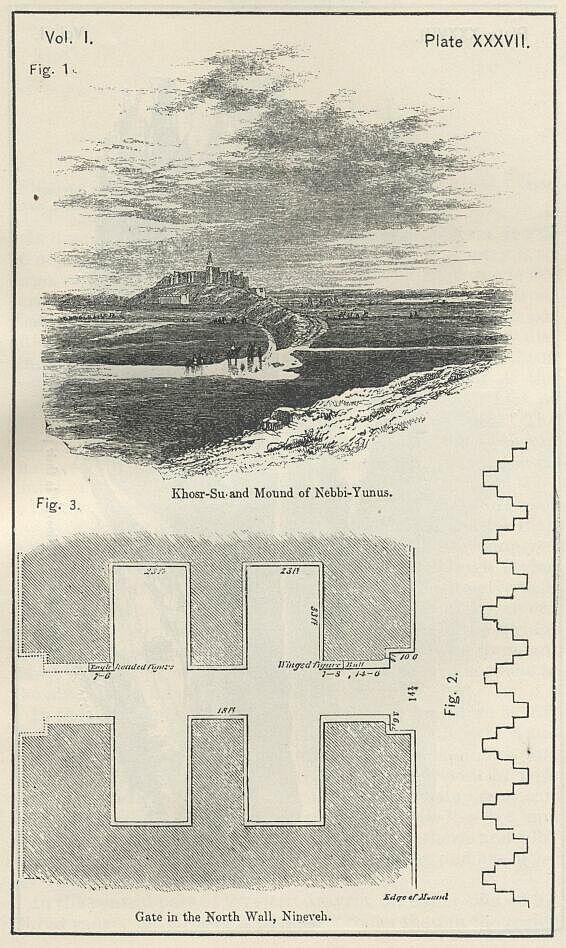
The mound of Nebbi-Ymus is at its base nearly triangular: [PLATE XXXVII., Fig. 1.] It covers an area of about forty acres. It is loftier, and its sides are more precipitous, than Koyunjik, especially on the west, where it abutted upon the wall of the city. The surface is mostly flat, but is divided about the middle by a deep ravine, running nearly from north to south, and separating the mound into an eastern and a western portion. The so-called tomb of Jonah is conspicuous on the north edge of the western portion of the mound, and about it are grouped the cottages of the Kurds and Turcomans to whom the site of the ancient Nineveh belongs. The eastern portion of the mound forms a burial-ground, to which the bodies of Mahometans are brought from considerable distances. The mass of earth is calculated at six and a half millions of tons; so that its erection would have given full employment to 10,000 men for the space of five years and a half.
These two vast mounds—the platforms on which palaces and temples were raised—are both in the same line, and abutted, both of them, on the western wall of the city. Their position in that wall is thought to have been determined, not by chance, but by design; since they break the western face of the city into three nearly equal portions. The entire length of this side of Nineveh was 13,600 feet, or somewhat more than two and a half miles. Anciently it seems to have immediately overhung the Tigris, which has now moved off to the west, leaving a plain nearly a mile in width between its eastern edge and the old rampart of the city. This rampart followed, apparently, the natural course of the river-bank; and hence, while on the whole it is tolerably straight, in the most southern of the three portions it exhibits a gentle curve, where the river evidently made a sweep, altering its course from south-east nearly to south.
The western wall at its northern extremity approaches the present course of the Tigris, and is here joined, exactly at right angles, by the northern, or rather the north-western, rampart, which runs in a perfectly straight line to the north-eastern angle of the city, and is said to measure exactly 7000 feet. This wall is again divided, like the western, but with even more preciseness, into three equal portions. Commencing at the north-eastern angle, one-third of it is carried along comparatively high ground, after which for the remaining two-thirds of its course it falls by a gentle decline towards the Tigris. Exactly midway in this slope the rampart is broken by a road, adjoining which is a remarkable mound, covering one of the chief gates of the city.
At its other extremity the western wall forms a very obtuse angle with the southern, which impends over a deep ravine formed by it winter torrent, and runs in a straight line for about 1000 yards, when it meets the eastern wall, with which it forms a slightly acute angle.
It remains to describe the eastern wall, which is the longest and the least regular of the four. Tins barrier skirts the edge of a ridge of conglomerate rock, which here rises somewhat above the level of the plain, and presents a slightly convex sweep to the north east. At first it runs nearly parallel to the western, and at right angles to the northern wall; but, after pursuing this course for about three quarters of a mile, it is forced by the natural convexity of the ridge to retire a little, and curving gently inwards it takes a direction much more southerly than at first, thus drawing continually nearer to the western wall, whose course is almost exactly south-east. The entire length of this wall is 16,000 feet, or above three miles. It is divided into two portions, whereof the southern is somewhat the longer, by the stream of the Khosr-Su; which coming from the north west, finds its way through the ruins of the city, and then runs on across the low plain to the Tigris.
The enceinte of Nineveh forms thus an irregular trapezium, or a "triangle with its apex abruptly cut off to the south." The breadth, even in the broadest part—that towards the north—is very disproportionate to the length, standing to it as four to nine, or as 1 to 2.25. The town is thus of an oblong shape, and so far Diodorus truly described it; though his dimensions greatly exceed the truth. The circuit of the walls is somewhat less than eight miles, instead of being more than fifty and the area which they include is 1100 English acres, instead of being 112,000!
It is reckoned that in a populous Oriental town we may compute the inhabitants at nearly, if not quite, a hundred per acre. This allows a considerable space for streets, open squares, and gardens, since it assigns but one individual to every space of fifty square yards. According to such a mode of reckoning, the population of ancient Nineveh, within the enceinte here described, may be estimated at 175,000 souls. No city of Western Asia is at the present day so populous.
In the above description of the ramparts surrounding Nineveh, no account has been given of their width or height. According to Diodorus, the wall wherewith Ninus surrounded his capital was 100 feet high, and so broad that three chariots might drive side by side along the top. Xenophon, who passed close to the ruins on his retreat with the Ten Thousand, calls the height 150 feet, and the width 50 feet. The actual greatest height at present seems to be 46 feet; but the debris at the foot of the walls are so great, and the crumbled character of the walls themselves is so evident, that the chief modern explorer inclines to regard the computation of Diodorus as probably no exaggeration of the truth. The width of the walls, in their crumbled condition, is from 100 to 200 feet.
The mode in which the walls were constructed seems to have been the following. Up to a certain height—fifty feet, according to Xenophon—they were composed of neatly-hewn blocks of a fossiliferous limestone, smoothed and polished on the outside. Above this, the material used was sun-dried brick. The stone masonry was certainly ornamented along its top by a continuous series of battlements or gradines in the same material [PLATE XXXVII., Fig. 2] and it is not unlikely that a similar ornamentation crowned the upper brick structure. The wall was pierced at irregular intervals by gates, above which rose lofty towers; while towers, probably of lesser elevation, occurred also in the portions of the wall intervening between one gate and another. A gate in the north-western rampart has been cleared by means of excavation, the form and construction of which will best appear from the annexed ground-plan. [PLATE XXXVII., Fig. 3.] It seems to have consisted of three gateways, whereof the inner and outer were ornamented with colossal human-headed hulls and other figures, while the central one was merely panelled with slabs of alabaster. Between the gateways were two large chambers, 70 feet long by 23 feet wide, which were thus capable of containing a considerable body of soldiers. The chambers and gateways are supposed to have been arched over, like the castles' gates on the bas-reliefs. The gates themselves have wholly disappeared: but the debris which filled both the chambers and the passages contained so much charcoal that it is thought they must have been made, not of bronze, like the gates of Babylon, but of wood. The ground within the gate-way was paved with large slabs of limestone, still bearing the marks of chariot wheels.
The castellated rampart which thus surrounded and guarded Nineveh did not constitute by any means its sole defence. Outside the stone basement wall lay on every side a water barrier, consisting on the west and south of natural river courses; on the north and east, of artificial channels into which water was conducted from the Khosr-su. The northern and eastern walls were skirted along their whole length by a broad and deep moat, into which the Khosr-su was made to flow by occupying its natural bed with a strong dam carried across it in the line of the eastern wall, and at the point where the stream now enters the enclosure. On meeting this obstruction, of which there are still some remains, the waters divided, and while part flowed to the south-east, and reached the Tigris by the ravine immediately to the south of the city, which is a natural water-course, part turned at an acute angle to the north-west, and, washing the remainder of the eastern and the whole of the northern wall, gained the Tigris at the north-west angle of the city, where a second dam kept it at a sufficient height. Moreover, on the eastern face, which appears to have been regarded as the weakest, a series of outworks were erected for the further defence of the city. North of the Khosr, between the city wall and that river, which there runs parallel to the wall and forms a sort of second or outermost moat, there are traces of a detached fort of considerable size, which must have strengthened the defences in that quarter. South and south-east of the Khosr, the works are still more elaborate. In the first place, from a point where the Khosr leaves the hills and debouches upon comparatively low ground, a deep ditch, 200 feet broad, was carried through compact silicious conglomerate for upwards of two miles, till it joined the ravine which formed the natural protection of the city upon the south. On either side of this ditch, which could be readily supplied with water from the Khosr at its northern extremity, was built a broad and lofty wall; the eastern one, which forms the outermost of the defences, rises even now a hundred feet above the bottom of the ditch on which it adjoins. Further, between this outer barrier and the city moat wall interposed a species of demilune, guarded by a double wall and a broad ditch and connected (as is thought) by a covered way with Neneveh itself. Thus the city was protected on this, its most vulnerable side, towards the centre by five walls and three broad and deep moats; towards the north, by a wall, a moat, the Khosr, and a strong outpost; towards the south by two moats and three lines of rampart. The breadth of the whole fortification on this side is 2200 feet, or not far from half a mile. [PLATE XXXVIII.]
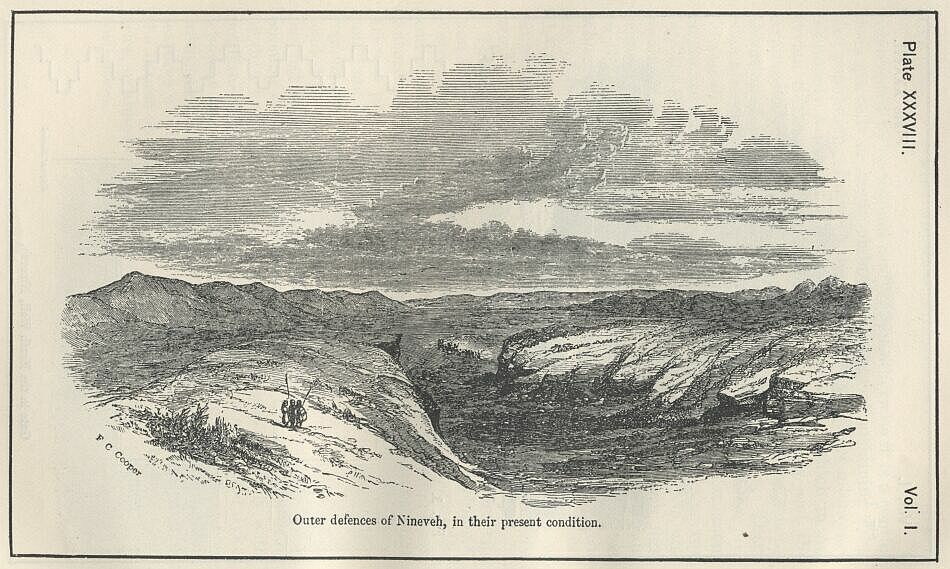
Such was the site, and such were the defences, of the capital of Assyria. Of its internal arrangements but little can be said at present, since no general examination of the space within the ramparts has been as yet made, and no ancient account of the interior has come down to us. We can only see that the side of the city which was most fashionable was the western, which immediately overhung the Tigris; since here were the palaces of the kings, and here seem also to have been the dwellings of the richer citizens; at least, it is on this side in the space intervening between Koyunjik and the northern rampart, that the only very evident remains of edifices—besides the great Mounds of Koyunjik and Nebbi-Yunus—are found. The river was no doubt the main attraction; but perhaps the western side was also considered the most secure, as lying furthest frown the quarter whence alone the inhabitants expected to be attacked, namely, the east. It is impossible at present to give any account of the character of the houses or the the direction of the streets. Perhaps the time may not be far distant when more systematic and continuous efforts will be made by the enterprise of Europe to obtain full knowledge of all the remains which still lie buried at this interesting site. No such discoveries are indeed to be expected as those which have recently startled the world but patient explorers would still be sure of an ample reward, were they to glean, after Layard in the field from which he swept so magnificent a harvest.
Greek phrase [—]—HEROD. iv. 137.
There has never been much difference of opinion among the learned with regard to the language spoken by the Assyrians. As the Biblical genealogy connected Asshur with Eber and Aram, while the Greeks plainly regarded the Syrians, Assyrians, and Babylonians as a single race, it was always supposed that the people thus associated must have possessed a tongue allied, more or less closely, to the Hebrew, the Syriac, and the Chaldee. These tongues were known to be dialectic varieties of a single form of speech the Semitic; and it was consequently the general belief, before any Assyrian inscriptions had been disinterred, that the Assyrian language was of this type, either a sister tongue to the three above mentioned, or else identical with some one of them. The only difficulty in the way of this theory was the supposed Medo-Persic or Arian character of a certain number of Assyrian royal names; but this difficulty was thought to be sufficiently met by a suggestion that the ruling tribe might have been of Median descent, and have maintained its own national appellatives, while the mass of the population belonged to a different race. Recent discoveries have shown that this last suggestion was needless, as the difficulty which it was intended to meet does not exist. The Assyrian names which either history or the monuments have handed down to us are Semitic, and not Arian. It is only among the fabulous accounts of the Assyrian Empire put forth by Ctesias that Arian names, such as Xerxes, Arius, Armamithres, Mithraus, etc., are to be found.
Together with the true names of the Assyrian kings, the mounds of Mesopotamia have yielded up a mass of documents in the Assyrian language, from which it is possible that we may one day acquire as full a knowledge of its structure and vocabulary as we possess at present of Greek or Latin. These documents have confirmed the previous belief that the tongue is Semitic. They consist, in the first place, of long inscriptions upon the slabs of stone with which the walls of palaces were panelled, sometimes occupying the stone to the exclusion of any sculpture, sometimes carried across the dress of figures, always carefully cut, and generally in good preservation. Next in importance to these memorials are the hollow cylinders, or, more strictly speaking, hexagonal or octagonal prisms, made in extremely fine and thin terra cotta, which the Assyrian kings used to deposit at the corners of temples, inscribed with an account of their chief acts and with numerous religious invocations. [PLATE XXXIX., Fig. 1.] These cylinders vary from a foot and a half to three feet in height, and are covered closely with a small writing, which it often requires a good magnifying glass to decipher. A cylinder of Tiglath-Pileser I. (about B.C. 1180) contains thirty lines in a space of six inches, or five lines to an inch, which is nearly as close as the type of the present volume. This degree of closeness is exceeded on a cylinder of Asshur-bani-pal's (about B.C. 660), where the lines are six to the inch, or as near together as the type of the Edinburgh Review. If the complexity of the Assyrian characters be taken into account, and if it be remembered that the whole inscription was in every ease impressed by the hand, this minuteness must be allowed to be very surprising. It is not favorable to legibility; and the patience of cuneiform scholars has been severely tried by a mode of writing which sacrifices everything to the desire of crowding the greatest possible quantity of words into the smallest possible space. In one respect, however, facility of reading is consulted, for the inscriptions on the cylinders are not carried on in continuous lines round all the sides, but are written in columns, each column occupying a side. The lines are thus tolerably short; and the whole of a sentence is brought before the eye at once.
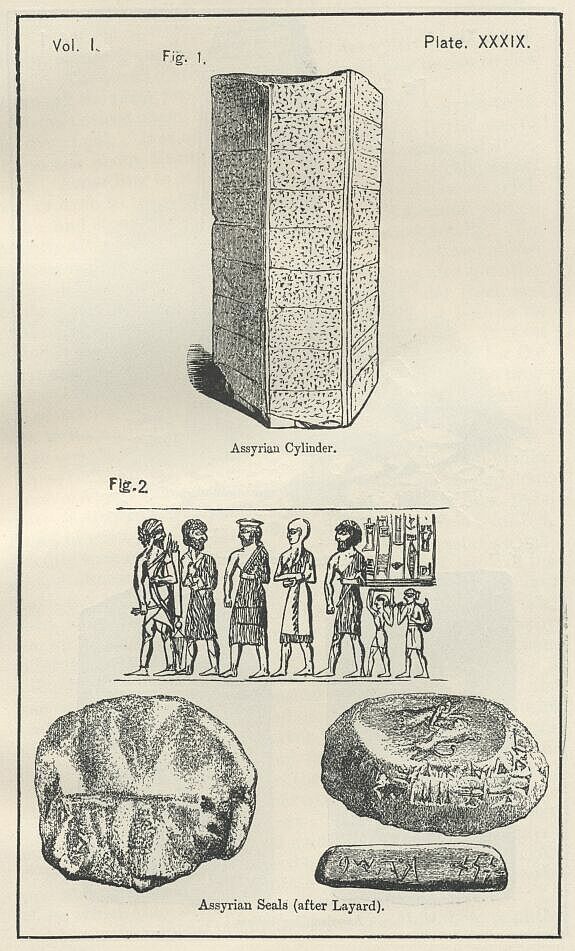
Besides slabs and cylinders, the written memorials of Assyria comprise inscribed bulls and lions, stone obelisks, clay tablets, bricks, and engraved seals. Tin seals generally resemble those of the Chaldaeans, which have been already described: but are somewhat more elaborate, and more varied in their character. [PLATE XXXIX., Fig. 2.] They do not very often exhibit any writing; but occasionally they are inscribed with the name of their owner, while in a few instances they show an inscription of some length. The clay tablets are both numerous and curious. They are of various sizes, ranging from nine inches long by six and a half wide, to an inch and a half long by an inch wide, or even less. [PLATE XL., Fig. 2.] Sometimes they are entirely covered with writing; while sometimes they exhibit on a portion of their surface the impressions of seals, mythological emblems, and the like. Some thousands of them have been recovered; and they are found to be of the most varied character. Many are historical, still more mythological; some are linguistic, some geographic, some again astronomical. It is anticipated that, when they are deciphered, we shall obtain a complete eneyclopaedia of Assyrian science, and shall be able by this means to trace a large portion of the knowledge of the Greeks to an Oriental source. Here is a mine still very little worked, from which patient and cautious investigators may one day extract the most valuable literary treasures. The stone obelisks are but few, and are mostly in a fragmentary condition. One alone is perfect—the obelisk in black basalt, discovered by Mr. Layard at Nimrud, which has now for many years been in the British Museum. [PLATE XL., Fig. 1.] This monument is sculptured on each of its four sides, in part with writing and in part with bas-reliefs. It is about seven feet high, and two feet broad at the base, tapering gently towards the summit, which is crowned with three low steps, or gradines. The inscription, which occupies the upper and lower portion of each side, and is also carried along the spaces between the bas-reliefs, consists of 210 clearly cut lines, and is one of the most important documents that has come down to us. It gives an account of various victories gained by the monarch who set it up, and of the tribute brought him by several princes. The inscribed lions and bulls are numerous. They commonly guard the portals of palaces, and are raised in a bold relief on alabaster slabs. The writing does not often trench upon the sculpture, but covers all those portions of the slabs which are not occupied by the animal. It is usually a full account of some particular campaign, which was thus specially commemorated, giving in detail what is far more briefly expressed in the obelisk and slab inscriptions.
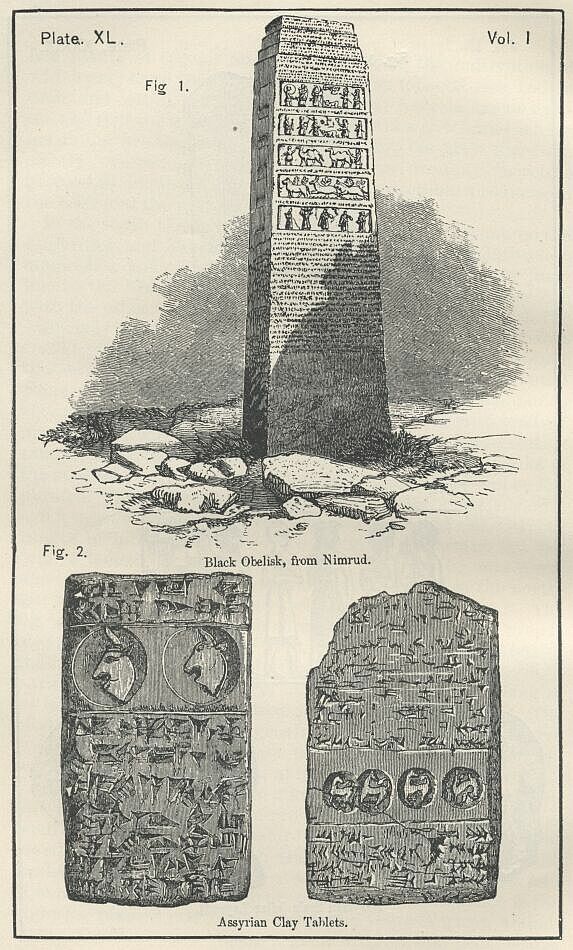
This review of the various kinds of documents which have been discovered in the ancient cities of Assyria, seems to show that two materials were principally in use among the people for literary purposes, namely, stone and moist clay. The monarchs used the former most commonly, though sometimes they condescended for some special object to the coarser and more fragile material. Private persons in their business transactions, literary and scientific men in their compositions, employed the latter, on which it was possible to write rapidly with a triangular instrument, and which was no doubt far cheaper than the slabs of fine stone, which were preferred for the royal inscriptions. The clay documents, when wanted for instruction or as evidence, were carefully baked; and thus it is that they have come down to us, despite their fragility, often in as legible a condition, with the letters as clear and sharp, as any legend on marble, stone, or metal that we possess belonging to Greek or even to Roman times. The best clay, skilfully baked, is a material quite as enduring as either stone or metal, resisting many influences better than either of those materials.
It may still be asked, did not the Assyrians use other materials also? Did they not write with ink of some kind on paper, or leather, or parchment? It is certain that the Egyptians had invented a kind of thick paper many centuries before the Assyrian power arose; and it is further certain that the later Assyrian kings had a good deal of intercourse with Egypt. Under such circumstances, can we suppose that they did not import paper from that country? Again, the Persians, we are told, used parchment for their public records. Are not the Assyrians a much more ingenious people, likely to have done the same, at any rate to some extent? There is no direct evidence by which these questions can be determinately answered. No document on any of the materials suggested has been found. No ancient author states that the Assyrians or the Babylonians used them. Had it not been for one piece of indirect evidence, it would have seemed nearly certain that they were not employed by the Mesopotamian races. In some of the royal palaces, however, small humps of fine clay have been found, bearing the impressions of seals, and exhibiting traces of the string by which they were attached to documents, while the documents themselves, being of a different material, have perished. It seems probable that in these instances some substance like paper or parchment was used; and thus we are led to the conclusion that, while clay was the most common, and stone an ordinary writing material among the Assyrians, some third substance, probably Egyptian paper, was also known, and was used occasionally, though somewhat rarely, for public documents.
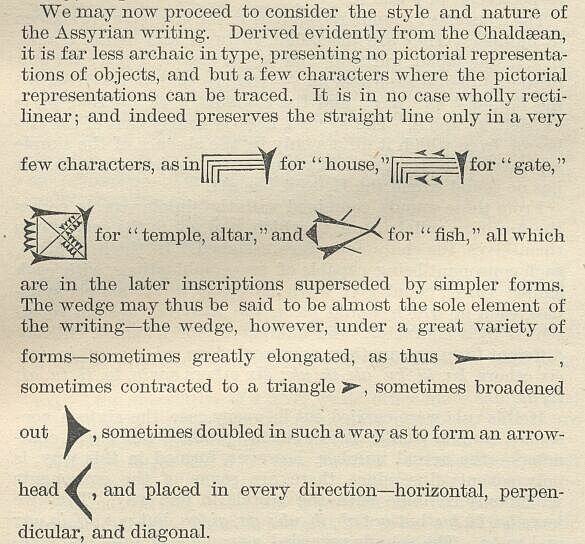
The number of characters is very great. Sir H. Rawlinson, in the year 1851, published a list of 216, or, including variants, 366 characters, as occurring in the inscriptions known to him. M. Oppei t, in 1858, gave 318 forms as those "most in use." Of course it is at once evident that this alphabet cannot represent elementary sounds. The Assyrian characters do, in fact, correspond, not to letters, according to our notion of letters, but to syllables. These syllables are either mere vowel sounds, such as we represent by our vowels and diphthongs, or such sounds accompanied by one or two consonants.
The vowels are not very numerous. The Assyrians recognize three only as fundamental—a, i, and u. Besides these they have the diphthongs ai, nearly equivalent to e, and au, nearly equivalent to o. The vowels i and u have also the powers, respectively, of y and v.

From these sounds, combined with the simple vowels, comes the Assyrian syllabarium, to which, and not to the consonants themselves, the characters were assigned. In the first place, each consonant being capable of two combinations with each simple vowel, could give birth naturally to six simple syllables, each of which would be in the Assyrian system represented by a character. Six characters, for instance, entirely different from one another, represented pa, pi, pu, ap, ip, up; six others, ka, ki, ke, ak, ik, uk; six others again, ta, ti, tu, at, it, ut.
If this rule were carried out in every case, the sixteen consonant sounds would, it is evident, produce ninety-six characters. The actual number, however, formed in this way, is only seventy-five. Since these are seven of the consonants which only combine with the vowels in one way. Thus we have ba, bi, bu, but not ab, ib, ub; ga, qi, gu, but not ay, iq,ug; and so on. The sounds regarded as capable of only one combination are the mediae, b, q, d; the aspirates kh, tj; and the sibilants ts and z.
Such is the first and simplest syllabarium: but the Assyrian system does not stop here. It proceeds to combine with each simple vowel sound two consonants, one preceding the vowel and the other following it. If this plan were followed out to the utmost possible extent, the result would be an addition to the syllabarium of seven hundred and sixty-eight sounds, each having its proper character, which would raise the number of characters to between eight and nine hundred! Fortunately for the student, phonetic laws and other causes have intervened to check this extreme luxuriance; and the combinations of this kind which are known to exist, instead of amounting to the full limit of seven hundred and sixty-eight, are under one hundred and fifty. The known Assyrian alphabet is, however, in this way raised from eighty, or, including variants, one hundred, to between two hundred and forty and two hundred and fifty characters.

Finally, there are a certain number of characters which have been called "ideographs," or "monograms." Most of the gods, and various cities and countries, are represented by a group of wedges, which is thought not to have a real phonetic force, but to be a conventional sign for an idea, much as the Arabic numerals, 1, 2, 3. etc., are non-phonetic signs representing the ideas, one, two, three, etc. The known characters of this description are between twenty and thirty.
The known Assyrian characters are thus brought up nearly to three hundred! There still remain a considerable number which are either wholly unknown, or of which the meaning is known, while the phonetic value cannot at present be determined. M. Oppert's Catalogue contains fourteen of the former and fifty-nine of the latter class.
It has already been observed that the monumental evidence accords with the traditional belief in regard to the character of the Assyrian language, which is unmistakably Semitic. Not only does the vocabulary present constant analogies to other Semitic dialects, but the phonetic laws and the grammatical forms are equally of this type. At the same time the language has peculiarities of its own, which separate it from its kindred tongues, and constitute it a distinct form of Semitic speech, not a mere variety of any known form. It is neither Hebrew, nor Arabic, nor Phoenician, nor Chaldee, nor Syriac, but a sister tongue to these, having some analogies with all of them, and others, more or fewer, with each. On the whole, its closest relationship seems to be with the Hebrew, and its greatest divergence from the Aramaic or Syriac, with which it was yet, locally, in immediate connection.
To attempt anything like a full illustration of these statements in the present place would be manifestly unfitting. It would be to quit the province of the historian and archeologist, in order to enter upon that of the comparative philologer or the grammarian. At the same time a certain amount of illustration seems necessary, in order to show that the statements above made are not mere theories, but have a substantial basis.
The Semitic character of the vocabulary will probably be felt to be sufficiently established by the following lists:
